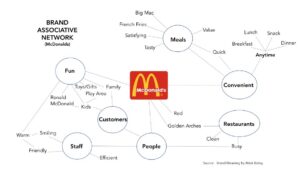Long-term success for any business depends on the skillful and appropriate use of branding and marketing. Often (incorrectly) used interchangeably, the two disciplines are related and complementary, but very different in terms of impact on sales, profitability and creation of tangible value.
The Business Value of Branding
Companies create brands to attract customers by differentiating their products or services from alternatives in a memorable way. Brand image is most often thought of as a distinctive logo, color or sound that, ideally, customers come to readily associate with that brand (Nike’s swoosh, FedEx purple and orange, the voice of Amazon’s Alexa). But while these elements help make the brand memorable, it’s the meaningful promise they represent that sets expectations and leads to customer trial and purchase.
If a customer’s initial experience with a brand is exceptional, that individual is extremely likely to recall the interaction favorably when making future purchase decisions in the product category. Brands that consistently deliver great user experiences create a special bond with their customers that helps drive repeat purchases.
This bond is born out of the meaning regular customers begin to attach to the brand that extends beyond 
This “brand meaning” evolves into a powerful, intangible corporate asset. Ultimately, the brand helps make customer decision-making easy through both the real and perceived value it delivers. The financial value to the company is reflected in both recurring revenue from return customers and goodwill on the balance sheet.
Dimensions of Brand Meaning
A brand’s meaning is defined by functional and emotional benefits. Functional benefits take the form of a product or service that helps the buyer accomplish certain desired tasks. These can lay the foundation for brand differentiation if they represent unique and special meaning to buyers, allowing brand marketers to demand a premium price. For example, the various camera features of Google Pixel, Android and iPhones are frequently advertised to differentiate each brand and substantiate their price/value.
Early in a brand’s lifecycle, functional benefits are often the most influential source of meaning delivery. As competitors enter the product or service category, emotional benefits become much more important to brand differentiation and purchase decisions. For example, Samuel Adams is widely considered one of the first, if not the first, American craft beer. As more and more small breweries came online following its launch in 1984, the uniqueness of flavor that had initially set it apart became gradually less of a differentiator, and the emotional intangibles that had become associated with the Sam Adams brand—familiarity, social experiences and contribution to consumer self-image—became, arguably, much more important.
Whether derived from functional or emotional benefits, a brand’s meaning and perceived value reside in each customer’s mind and exercise a primary influence over purchase decisions. It’s critical, therefore, to have a clear, real-time understanding of your brand image—how your brand occurs publicly to consumers—and how well that image aligns with your stated promise of what customers can expect in doing business with you.
The Business Value of Marketing
So, a company’s brand represents what its products or services can do for customers and provides a connection that has them identify the brand with positive experiences in their own lives. Marketing, on the other hand, serves to accelerate awareness in the marketplace of the brand’s benefits and accessibility. In other words, marketing helps shape and deliver the brand’s meaning to the right people at the right place and time. How effectively and efficiently this is accomplished defines return on the company’s marketing investment and produces a measure of the brand’s impact on the P&L. Strong marketing boosts brand awareness and builds brand equity; poor marketing efforts can accelerate a brand’s financial decline.
Dimensions of Marketing
Legendary marketing expert, author and professor Philip Kotler defined marketing’s dimensions as four “Ps”: product, promotion, price and place. Although established in the 1960s, the definitions are, I believe, still the best way to understand and approach marketing today. Decisions made about the four Ps are highly influential in forming a brand’s meaning in the mind of the customer. And, as noted above, what a brand means to a customer is at the heart of brand value creation and purchase behavior (Philip Kotler, Marketing Management).
- PRODUCTS and/or services deliver the functional benefits of the brand proposition. Consumer research and marketplace experience guide marketing teams in determining which features are most important to the buyer or end user. This information is distilled into the purchase proposition—why this product or service is the best choice—which is then expressed on the package, website and through the most appropriate advertising communication channels and vehicles.The relevance of product or service benefits weighs heavily into the consumer’s perception of a brand’s value. How well the product meets or exceeds expectations will either enhance or erode customer perceptions of brand quality. This in turn impacts brand equity creation and financial performance (David Aaker, Branding Strategy Insider).
- PROMOTION of features and benefits also relies on consumer research, which identifies the demographics and psychographics of individuals with the highest potential for purchase. This information is used to craft the “likability” of advertising and marketing promotion—creativity, tone, level of sophistication—and influences not only customer expectations but also overall likability of the brand. This likability factor extends not only to messaging but also to how the product or service is presented, such as through packaging and label design, as well as how the marketing communications are delivered along the buyer’s path to purchase. Promotion might include purchase incentives designed to drive new product trial and adoption, or, later in the product lifecycle, to increase purchase quantity and frequency. As with the product quality dimension noted above, likability is a major intangible driver of brand equity creation (Erik du Plessis, The Advertised Mind).
- The product’s PRICE should reflect the cost to produce the product or service plus desired profit margin, tempered by the company’s assessment of the customer’s perceived value for the product or service. The greater the real and intangible value attached to the brand by the customer, the higher the price or margin above cost that can be set. The essence of pricing strategy, in fact, is to create brand associations that confer status by ownership of the product balanced with the affordability needed for market adoption. Price combined with product performance is critical to profitability and the company’s ability to fund the communications (promotion) necessary for competitor differentiation, building and sustaining brand awareness and achieving brand loyalty.
- The marketing dimension of PLACE has been influenced greatly by e-commerce as well as new types of brick-and-mortar shopping experiences, such as Ikea’s in-store “PJ Party” event to promote bedding products, or beauty retailer Sephora’s personal shopping assistant app for use while in-store. Brands representing “new-to-the-world” innovation often benefit from exposure in trusted retail outlets or through established online and in-person sales support systems to establish credibility and educate customers about new category benefits. For example, products introduced for pets might be most effectively sold through veterinarians or specialty pet retailers such as Petco and PetSmart, where questions can be easily answered by expert staff. The same might be true for specialized paints or coatings, for which a full-service hardware store or paint specialty retailer like Sherwin Williams or Benjamin Moore might be a key avenue for product introduction.
Brands positioned as high-quality and high-status need to be purposefully sold through strategically selected environments. Premium fashion items, for example, sell best in exclusive department stores or specialty boutiques where status brands are expected to be found. Such marketing “place” decisions not only provide access to consumers more likely to find the brand affordable, but association with a high-end retailer also helps confirm the quality and exclusivity of the product. Consumers shopping at Nordstrom or Bloomingdale’s, for example, would expect to pay more than they would at Target or JC Penney.
Mainstream product brands have benefited greatly from online e-commerce market access, especially small businesses using Amazon’s platform. The e-commerce user experience functions much like that of a brick-and-mortar outlet. The quality and ease of the shopping platform experience impact the image of the brands sold there. Zappos, Etsy and Overtstock.com are three good examples of how an e-commerce site can influence brand perceptions based on level of service, exclusivity and reputation for discount pricing.
Where Branding and Marketing Meet
Brands and marketing do intersect, of course, especially at the category level. Categories define the basic features and benefits relevant to consumer purchases. The brand’s primary meaning, therefore, begins with top-of-mind performance perceptions of the category to which the brand belongs (e.g., Kleenex means tissue, Bayer means aspirin, Gatorade means energy drink). Strategies to grow a brand financially are driven by marketing decisions that differentiate and create special meaning within the category.
Brand associative network models can be used to illustrate how a brand’s key characteristics are connected within a purchaser’s memory, creating brand equity. The brand associative network exhibit below shows these associations for the McDonald’s brand. The core brand identity is defined by the golden arches and the color red. From there, the influence of the 4 Ps of marketing can be seen on the brand’s expanded meaning: Place (restaurant), Product (food types, service), Price (food value) and Promotion (awareness of the company and its sub-brands such as Big Mac and Ronald McDonald). Note that the emotional characteristics of fun, warm, friendly and satisfying are derived from experiences that resulted from interactions with the McDonald’s staff, environment or food.
Just as the associative network provides insights on a brand’s meaning, quantitative measures provide insight into how many consumers are reached, influenced and purchase the brand. These metrics, when tracked over time, can provide indicators for estimating brand financial growth. Marketing performance measures most frequently used include awareness, familiarity, market accessibility, number of customers, website traffic, search popularity and success on social media. Performance metrics captured in large, statistically significant samples can also provide insights on the characteristics of a brand’s best customers and strength of the brand’s key differentiating attributes driving its selection.
Summary
Understanding the differences between branding and marketing is essential to using them together successfully. Your brand can’t be properly presented without a strong marketing effort, and your marketing campaigns will be ineffective without the guidance of a compelling brand strategy.
Once you identify how you want your brand to be perceived by the consumer, making marketing decisions that positively influence the brand’s ultimate perceived value becomes clearer and easier.
Ensuring that your branding and marketing are working in concert allows you to deliver your brand’s meaning more consistently, meeting and/or exceeding customer expectations and generating the long-term financial returns you are seeking.








